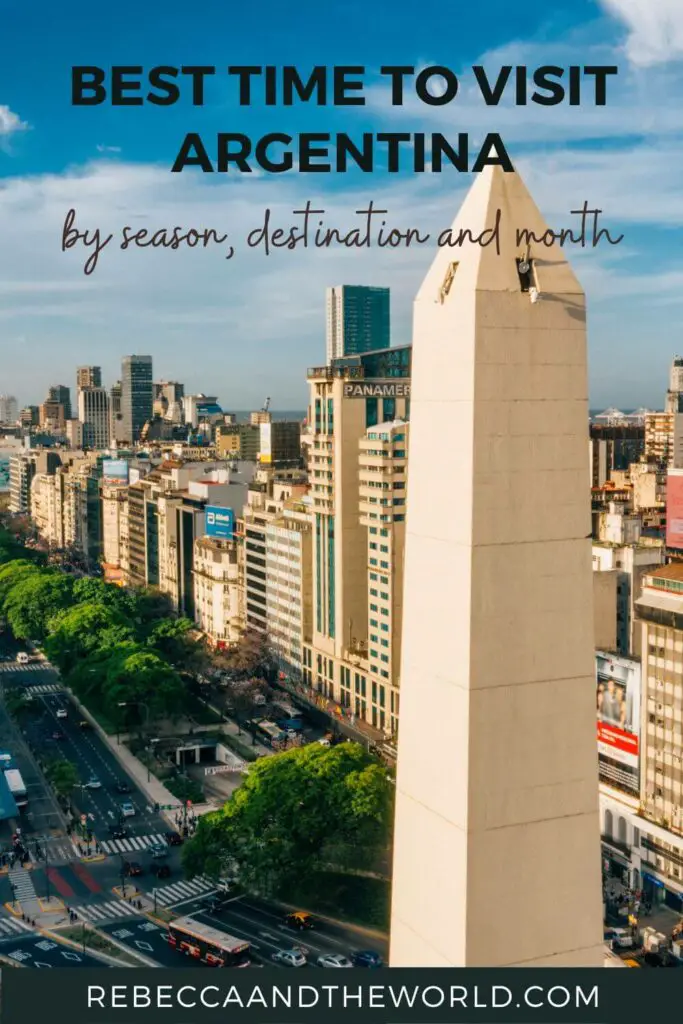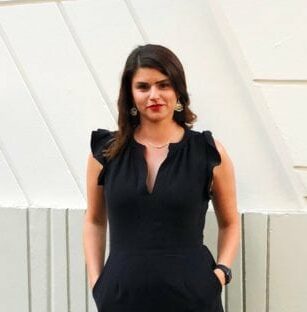Wondering when is the best time to visit Argentina? I lived in Argentina for two years and have experienced all the seasons, so this guide will help you plan the perfect trip with my seasonal recommendations.
Argentina is a huge country – the 8th largest in the world, in fact. This means that there’s a lot of diversity in geography and weather across the country.
That also means that there isn’t really a “one-size-fits-all” answer to the question of when is the best time to visit Argentina. It really does depend on what you want to do and see when you’re here.
Of course, some months are better suited for travel. As well as times of the year when you should avoid visiting certain parts of the country. As we all know, the weather can make or break a vacation!
Overall, though, there’s something amazing to do in Argentina year-round.
I lived in Argentina for two years, so I’ve experienced all the seasons. In this guide, I’m sharing a seasonal overview of the weather in Argentina – across all the regions – to help you plan your trip and get the most out of your visit. I’ve also got some month-to-month advice, including festivals and events you might like to plan your visit around.
Before we begin: For my northern hemisphere friends, don’t forget that Argentina’s seasons are the opposite! So December to February is our summer, and June to August is winter.
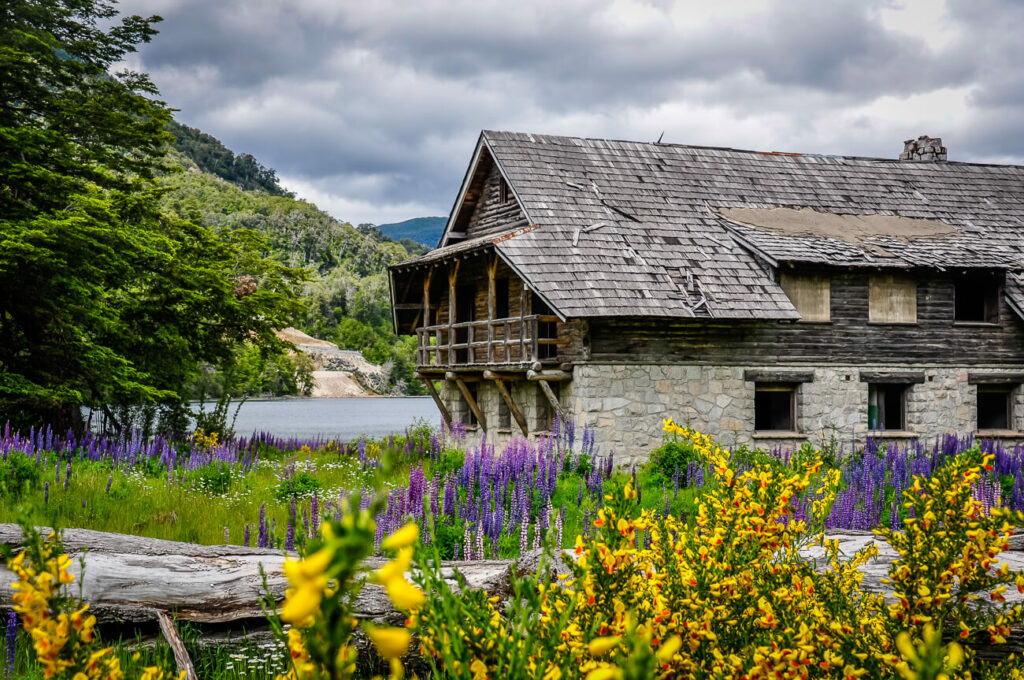
This blog post may contain affiliate links, meaning if you book or buy something through one of these links, I may earn a small commission (at no extra cost to you).
The best time to visit Argentina
The best time to visit Argentina is March/April and October/November. These are the shoulder seasons with fewer visitors and lower prices. The weather is mild and you’ll be able to visit almost all of the country.
That’s my quick answer if you don’t have time to read the whole article. This recommendation is for the “average” traveller, by which I mean someone who’s visiting to see the highlights of the country, maybe over 2 weeks in Argentina.
If you’re visiting Argentina for something specific, then my answer is completely different. If you’re here to go hiking in Patagonia, then summer is the best time to visit. Whereas if you want to hit the ski slopes, winter is your best bet.
Here are my general recommendations for the best time to visit Argentina based on what you want to do and see:
- For cities: March/April and October/November
- For hiking and outdoors: November-March
- For wine: March-May
- For skiing/snow activities: June-August
- For best prices and fewer crowds: March-June and September-November
Overall, my favourite time in Argentina is November. I just love spring when it’s warming up and the flowers are in bloom. Everyone’s feeling great after leaving the winter funk behind so there’s generally a great vibe across the country.
I’m guessing you’ve either already decided where you’re going in Argentina or you know when you’re coming to Argentina, so I’ve broken this article up into three sections. You can find the best time to visit Argentina:
Use those links above to jump to the section that you’re interested in.
Argentina by the seasons
The seasons of Argentina begin in the middle of the month – or, more specifically, around the 20th of each month.
I know this is the same for other countries like the USA, but this is unusual to me as an Australian! Our seasons always start on the first of the month (ie. summer begins on 1 December).
Let’s walk through each of the seasons and what you can expect from the different regions of Argentina.
When is high season in Argentina?
The high season in Argentina, when the country sees the most tourists, is December to February (summer) and July (winter ski season).
Here’s a quick overview of the tourist seasons:
- High Season: December to February (summer) and July (winter ski season) – expect higher prices and more visitors, including Argentines travelling
- Shoulder Season: March to April (fall/autumn) and September to November (spring) – more temperate weather, with more affordable pricing
- Low Season: May to June (late fall) and August (winter, excluding ski destinations) – fewer travellers, but some parts of the country may be closed to visitors (parts of Patagonia, for example)
Summer in Argentina: Mid-December to mid-March
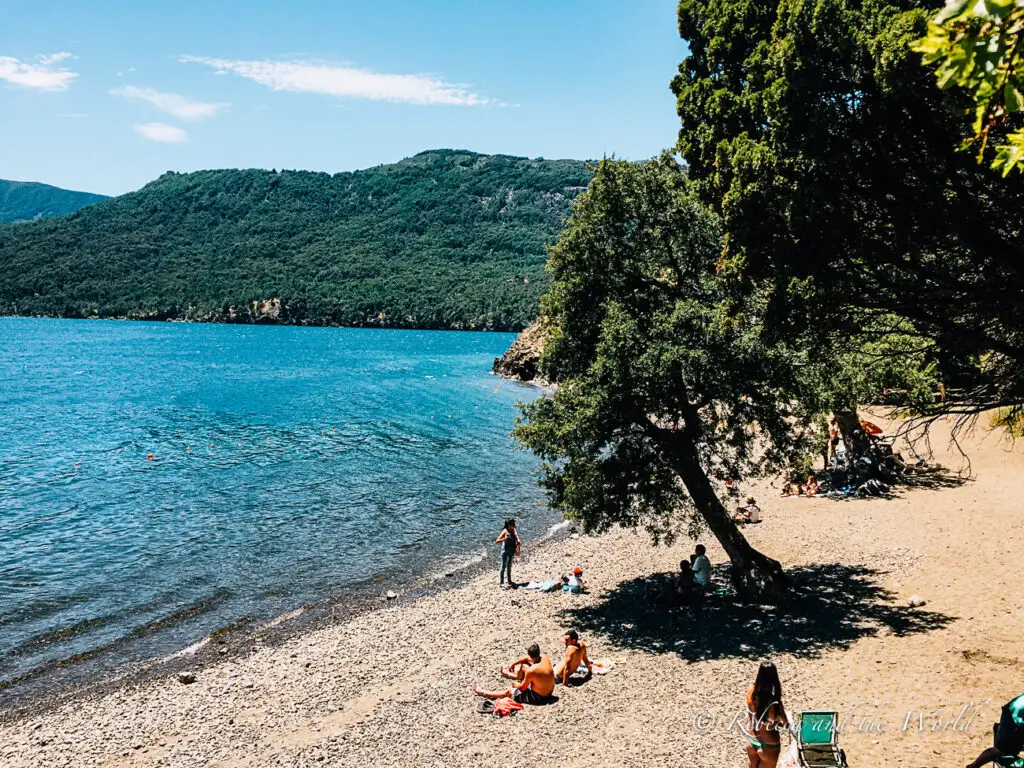
Summer, spanning mid-December to mid-March, brings sweltering, humid heat to Buenos Aires, where the city sizzles in temperatures that regularly hit the 30s (Celsius).
The city’s residents, known as Porteños, often escape to the coastal towns of Mar del Plata and Pinamar.
But this is the prime time for foreigners to visit Buenos Aires, and that means accommodation prices tend to climb. It’s a smart move to book ahead.
The beauty of summer is that the days are long, giving you around 14 glorious hours of sunlight each day in December and January. That’s plenty of time to squeeze in all the fun stuff you can do in Buenos Aires in 3 days!
Down in Patagonia, the story is a tad different. Summer months offer milder temperatures, but don’t let that fool you. Evenings can get chilly, and this place is famous for its year-round gusty winds. So, when you’re plotting your outdoor adventures, remember to account for the wind factor.
Despite that, summer’s the perfect time to explore Patagonia’s stunning landscapes, with extended daylight hours and open trails. But, brace yourself, you won’t be the only one with this grand idea – it’s the peak tourist season, from Bariloche in the north to Ushuaia in the south.
If you’re heading to Salta, up in the north, summer translates to one thing: HEAT. December and January are the hottest months here, and January also brings the most rain. Don’t fret, though. The showers are usually short and sweet, but the heat can be a bit intense.
Iguazu Falls is a popular summer spot. Just be ready to embrace the rain, as this is the rainy season’s peak. But guess what? The waterfalls are absolutely mind-blowing at this time. Make sure to pack a trusty waterproof jacket and sturdy shoes.
Argentina doesn’t do the daylight saving time dance, so your clocks won’t be springing forward or falling back here.
Pro tip: Stay hydrated in the heat – bring a reusable water bottle like this GRAYL bottle which also purifies your drinking water.
Autumn in Argentina: Mid-March to mid-June
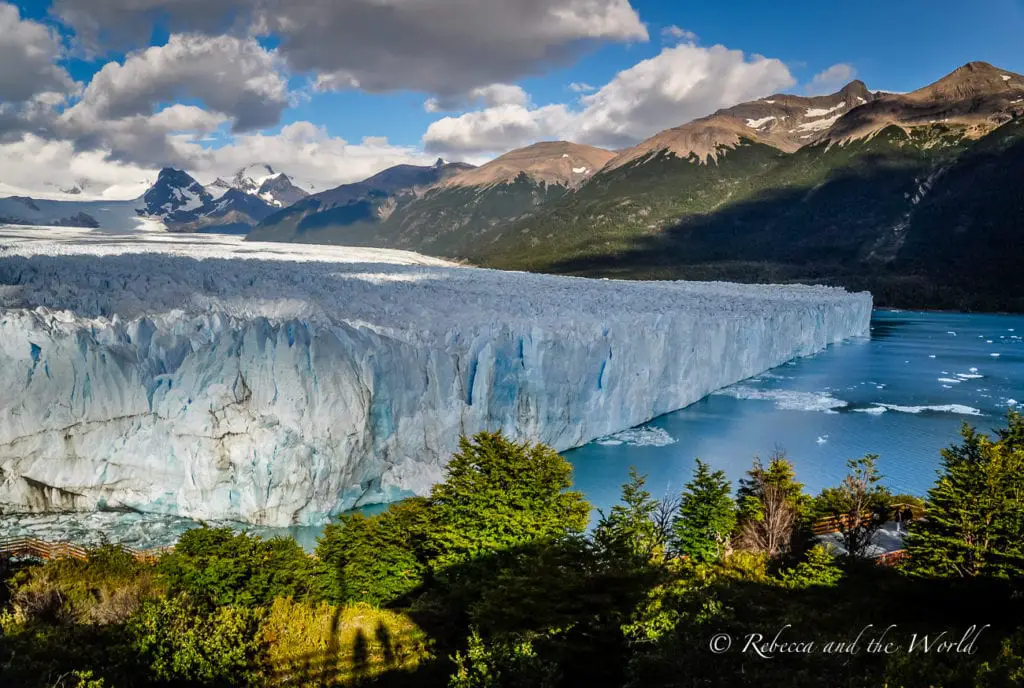
Autumn in Argentina delivers a shift from the sweltering summer heat to a more temperate climate.
In Buenos Aires, the weather is just right, with daytime temperatures hovering between 20-25°C. Evenings might give you a little chill, so don’t forget to pack a light jacket or sweater.
Mendoza, the wine lover’s paradise, is alive and kicking during autumn. This is harvest time and the vineyards are buzzing. Days are warm, but evenings cool down substantially, creating a perfect setting for a glass of wine by the fire.
Down in Patagonia, things get a tad frostier compared to the rest of the country. The temperature starts to plunge, ranging from 5-10°C. Sporadic snowflakes can fall in early autumn, with heavier snowfall usually making an appearance by May. If you’re seeking peace and quiet and don’t mind the unpredictability, it’s a great time to experience Patagonia without the crowds. Just be aware that some trails might close early due to snow.
In the northern regions, including Iguazu Falls and Salta, autumn is lovely. The summer rains subside and the weather is warm with lower humidity.
Iguazu Falls, while less torrential due to lower water levels, remains a must-see spectacle. This time of year is popular with visitors, as the heat is much more bearable.
In Salta, the landscapes are lush from the summer rains and the temperatures are far more manageable. March can still sprinkle a little rain on your parade.
Winter in Argentina: Mid-June to mid-September
Winter in Argentina varies across the country. In Buenos Aires, the winters are fairly mild. You won’t often find the mercury dipping below freezing, and snow doesn’t make an appearance in the city.
But if you venture into Patagonia be prepared for a completely different story. Winters here are the real deal, with heavy snowfall and temperatures that can plunge below freezing. In fact, many tourist spots shut their doors during this season because of the extreme conditions. Small towns like El Chaltén usually go into hibernation mode. But in other Patagonian destinations, like Ushuaia, there’s no shortage of snowy adventures, from dog sledding to ice trekking.
This is the prime time to ski in Argentina. Ski resorts like Las Leñas and Cerro Catedral reopen and Argentines and foreigners flock to them. July is the busiest – and most expensive – month to go skiing and snowboarding.
Up north, winter is mild and dry, and this is a great time to visit Iguazu Falls and Salta.
In Salta, the days are bathed in sunshine, with cooler nights.
At Iguazu Falls, the max temperature hovers around 24°C. Of course, you can still expect some rainy days, but hey, it’s always raining at Iguazu, regardless of the season. So, don’t let a little rain deter you from witnessing this natural marvel.
Spring in Argentina: Mid-September to mid-December
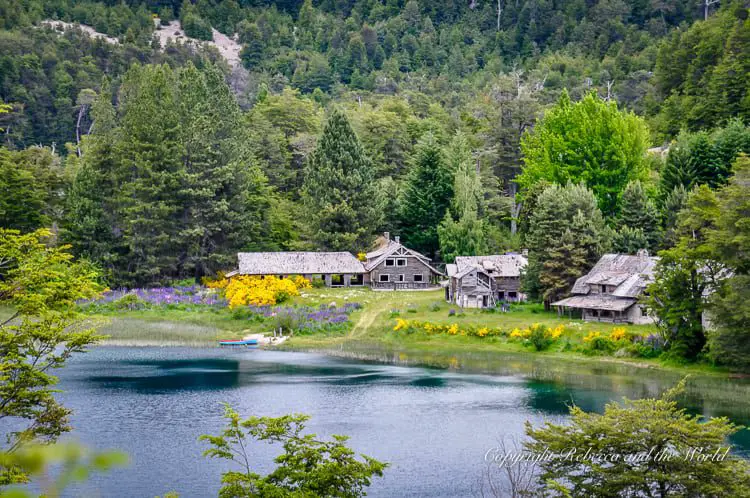
It’s hard not to fall in love with Argentina in spring – it’s my favourite time in Argentina. Spring brings a welcome reprieve from the winter chill, and plants and flowers begin to bloom with vibrant colours.
From mid-September to mid-December, temperatures across the country are comfortable, making sightseeing and outdoor activities enjoyable, whether you’re in the city or the countryside.
Plus, the added bonus is that it’s a budget-friendly season, with more lodging options available.
In Buenos Aires, spring serves up temperatures ranging from a comfy 15 to 25 degrees Celsius. An occasional rain shower keeps things fresh. October can get a bit wet, but that sets the stage for November when the jacaranda trees paint the city’s streets with stunning purple blooms. Trust me, it’s a sight you don’t want to miss, and reason enough to visit Buenos Aires.
In the Andean northwest, the snow begins to recede, making way for budding green landscapes. Temperatures in Mendoza range from 10-28 degrees Celsius, creating pleasant conditions for exploring the wine country or hiking in the Andes.
On the other hand, spring in Patagonia can still be quite chilly. Temperatures in Ushuaia rarely rise above 15 degrees Celsius, although it’s a few degrees warmer in northern Patagonia. Tourist spots begin to reopen, and the increasing daylight hours provide more opportunities for exploration.
In the north, spring means warm temperatures and an increase in rainfall. Iguazu Falls and Salta experience temperatures from 20-30 degrees Celsius, and the increased water flow at the falls is nature showing off at its best.
Best time to visit Argentina by destination
There are so many amazing places to visit in Argentina, and here I’ve broken down the best time to visit the main destinations.
When is the best time to visit Buenos Aires?
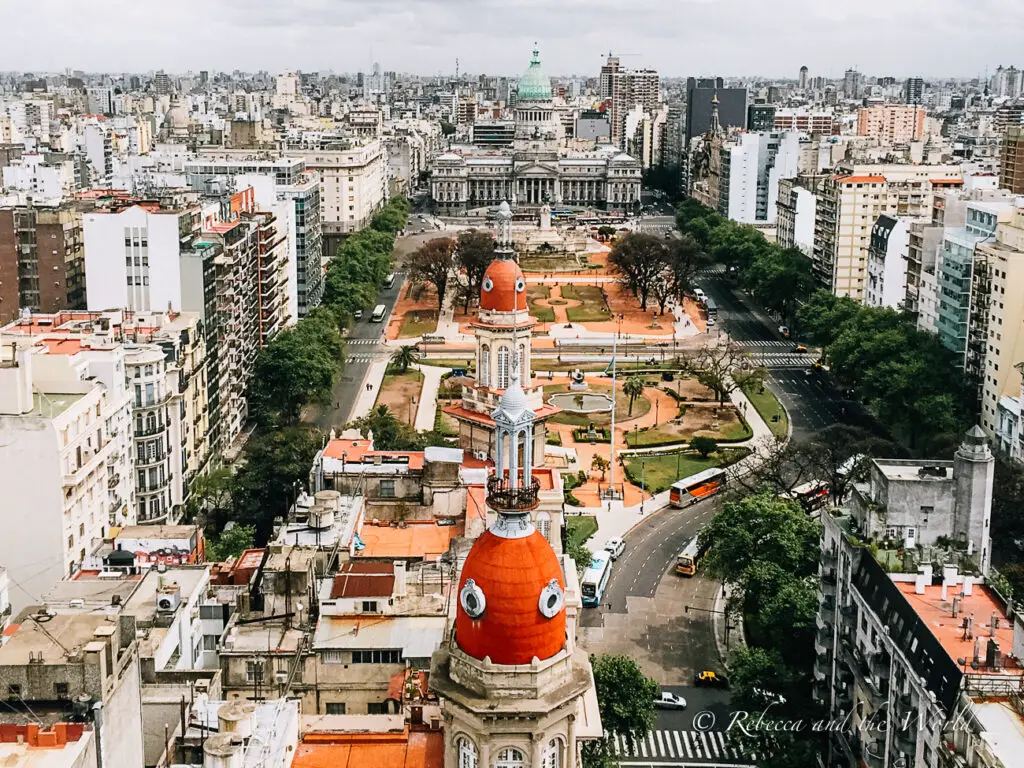
The best time to visit Buenos Aires is during the fall (March to May) or spring (September to November). These are considered the most pleasant seasons with mild temperatures and less rainfall. There are also fewer crowds, which means more accommodation options and lower prices.
November is my favourite month in Buenos Aires when the jacaranda trees burst into bloom. The purple-lined streets are stunning, and it’s one of the best things to see in Buenos Aires.
January in Buenos Aires is hot and muggy and not a pleasant time to visit.
When is the best time to visit Patagonia?
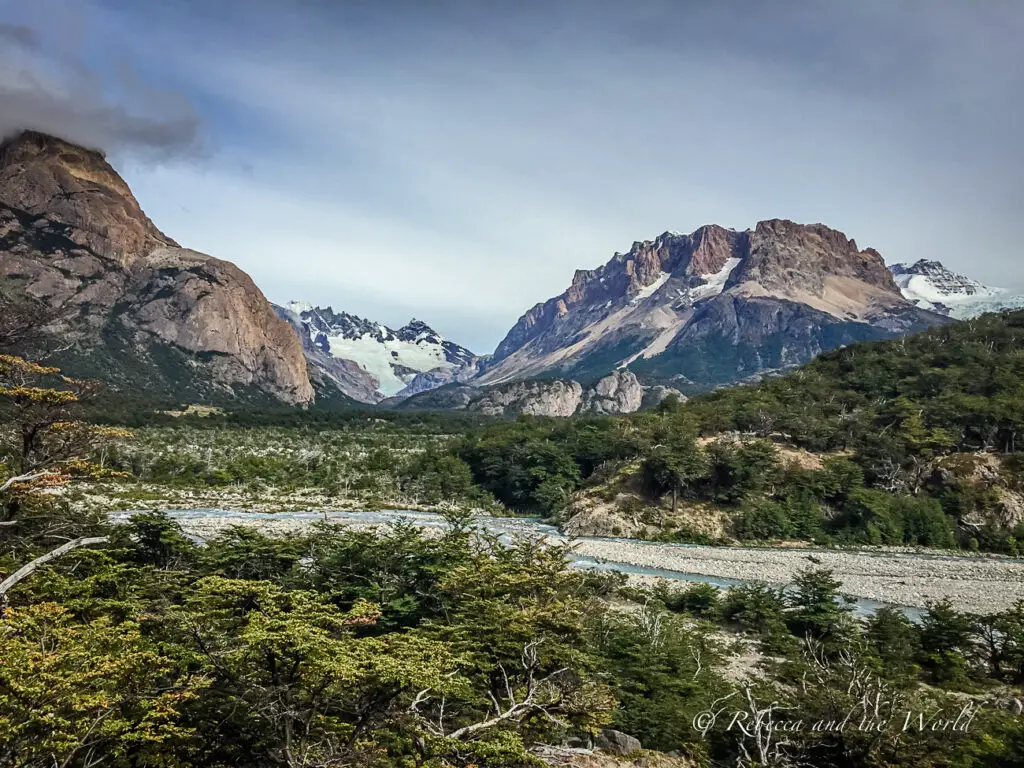
The best time to visit Patagonia depends on what activities you’ve got planned.
For trekking, hiking and outdoor adventures, the best time is between November and March when the temperatures are milder. Depending on how the season is going, you might even be able to stretch that from October to April.
For skiing and snow activities, the best time is during June to August. July is the busiest and most expensive month for skiing.
The weather in Patagonia can be unpredictable year-round, so keep this in mind when planning your trip.
When is the best time to visit Mendoza?
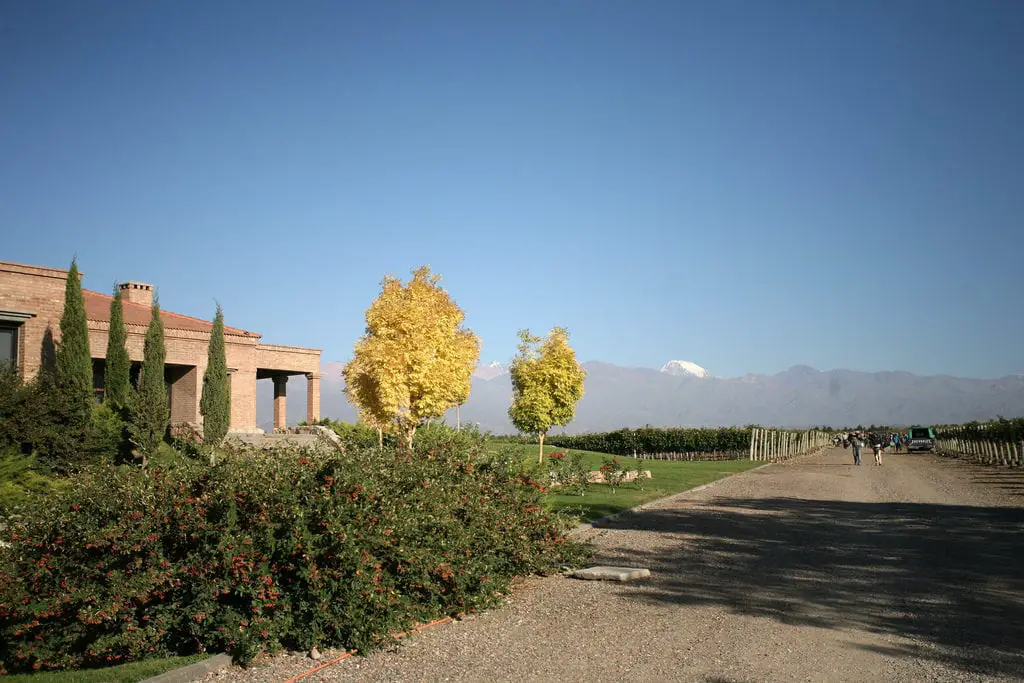
You can go wine-tasting year-round! The best of Mendoza’s wine harvest (including the city’s main wine festival) happens in March-May. If you’re a wine lover, this is the time to visit.
Spring is also nice – the weather is lovely although the vines won’t be full.
I’ve visited Mendoza in the dead of winter and it was cold but not unpleasant. The wineries remain open for tastings and visits, but without the grapevines they don’t look as lovely as other times of the year.
When is the best time to visit Iguazu Falls?
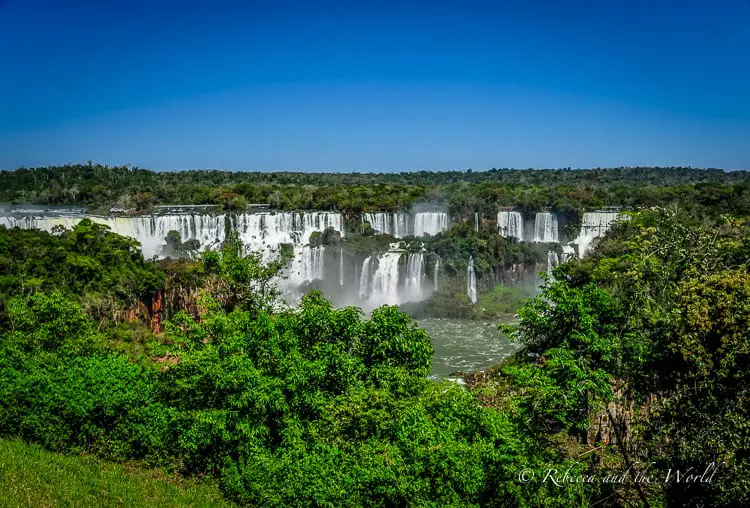
Iguazu’s subtropical climate means it’s warm and humid all year round. And it rains year-round – there’s just no way to avoid it. August sees the least rainfall.
April and May and September and October are nice months to visit.
Regardless of the time of year, pack a raincoat or buy one of the ponchos on sale at the falls.
When is the best time to visit Northwest Argentina?
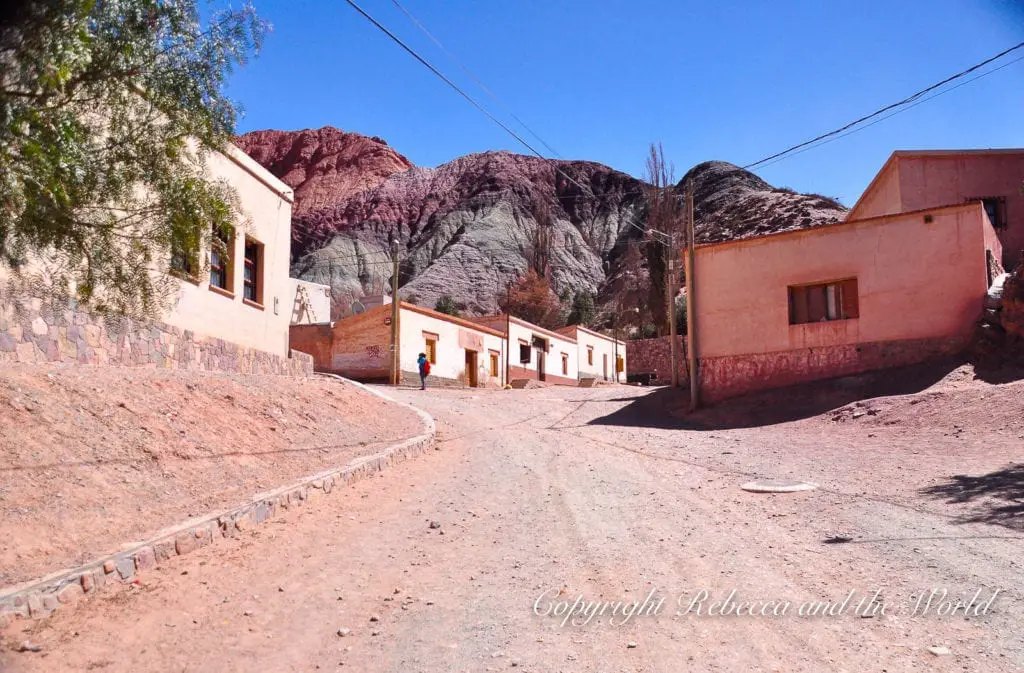
The best time to visit Northwest Argentina is from around April to November when the temperature is milder. The winter months get the least rainfall.
We visited north Argentina in September and it was perfect – warm, sunny days exploring the wineries in Cafayate, which we followed by rugging up for the cooler evenings.
Month-to-month guide to Argentina
Do you have a timeframe in mind to visit Argentina? This next section will help you understand what it’s like across the country from month to month.
I’ve also included major events and public holidays – Argentines love a celebration, so you can even plan a trip around some of these.
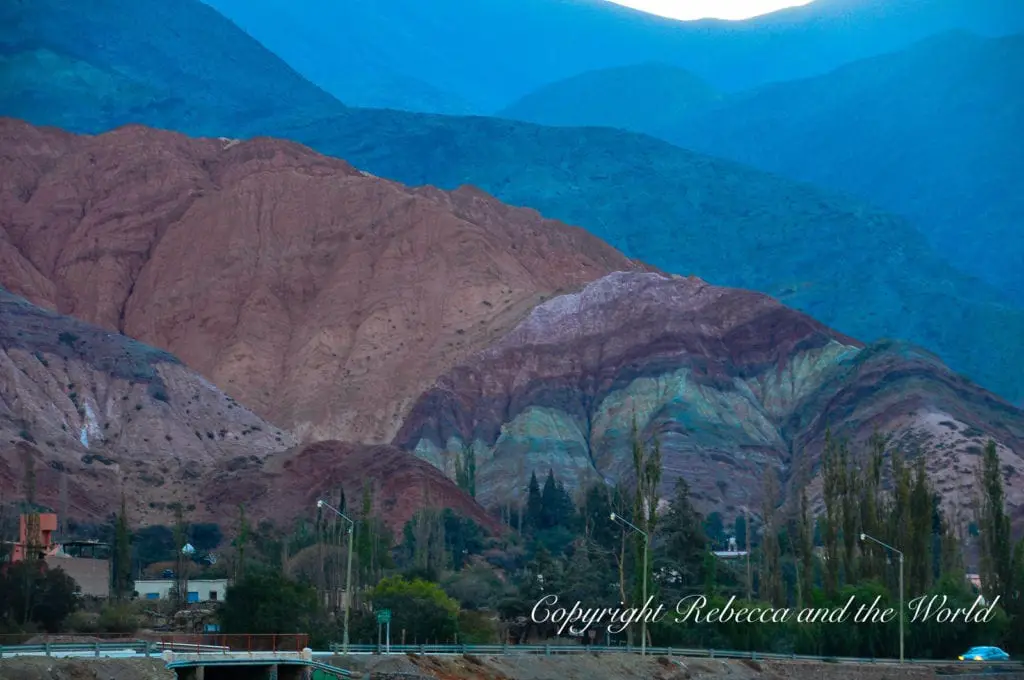
January in Argentina
January in Argentina is summer time and it brings with it sweltering heat. It also brings the peak tourist month, so prepare to battle with crowds if you choose to visit in January.
Argentines tend to clear out of Buenos Aires in January to take their own holidays. This may mean less traffic around the city, but I think the city loses a bit of its vibe without the locals.
Conversely, January is Argentina’s peak travel season, so you’ll see more foreign tourists here this month. Which leads to higher prices and accommodation booking out, so make sure you book well in advance.
The heat means it’s a great time to be by the beach – but every Argentine will also be there and will have booked well ahead of you!
This is the best time of the year to be heading south to take advantage of the warmer weather and longer days. Patagonia and Tierra del Fuego are open for business, but be aware that it’s peak tourist season there, too. Bariloche is another great spot to visit in January – but again, it’ll be busy.
Where not to go in January: Salta and Northwest Argentina, which will be baking
Public holidays: New Year’s Day (1 January)
| City | Ave. temp (°C) | Ave. temp (°F) | Ave. rainfall (mm) |
| Buenos Aires | 30.5 | 86.9 | 109 |
| Puerto Iguazu | 32.5 | 90.5 | 175 |
| Salta | 22.2 | 72.0 | 172 |
| Mendoza | 32.6 | 90.7 | 19 |
| Bariloche | 19.7 | 67.5 | 83 |
| Ushuaia | 11.8 | 53.2 | 47 |
February in Argentina
January’s recommendations apply equally to February, although the crowds start to thin out. However, I’d still recommend booking hotels and tours in advance.
It’s still hot throughout the country, so you can continue to enjoy the warm weather – although it’ll be sticky-hot in most places.
Carnaval kicks off in February, the week before the start of Lent. It’s not celebrated on the scale of neighbouring Rio de Janeiro, but there are still some fun activities in Buenos Aires with music and dancing.
The best place to celebrate is in Gualeguaychú, Entre Ríos, which is a 3-hour bus ride from Buenos Aires. It’s worth the trip if you love a party!
Where not to go in February: Salta and Northwest Argentina, where temperatures can be high during the day and heavy rains can cut off roads
| City | Ave. temp (°C) | Ave. temp (°F) | Ave. rainfall (mm) |
| Buenos Aires | 29.4 | 85.1 | 115 |
| Puerto Iguazu | 31.5 | 88.7 | 163 |
| Salta | 21.7 | 71.1 | 159 |
| Mendoza | 31.2 | 88.2 | 15 |
| Bariloche | 18.8 | 65.8 | 74 |
| Ushuaia | 11.3 | 52.3 | 42 |
March in Argentina
March is the beginning of autumn in Argentina, which brings cooler temperatures and fewer tourists. This can be a great time to visit as you won’t have to deal with the summer crowds and prices start to drop.
This is the best time to go to Argentina’s main wine region, Mendoza, to visit the wineries. The Mendoza Wine Harvest Festival is held each March and the festivities include wine tastings, music and grape stomping.
Bariloche and the Lake District are beautiful this time of year, as the leaves start to change colour. The summer crowds have dissipated, but it’s still warm enough to get outdoors and drive or cycle the Ruta de Los Siete Lagos.
Patagonia is still open, and autumn brings beautiful colours to the trees and landscapes. It’s a great time for hiking in El Chaltén and other outdoor activities before the winter cold sets in.
It’s important to note that Easter falls in late March or early April depending on the year. If you plan to visit during this holiday, make sure to book your accommodation in advance, as it’s a popular time for Argentinians to travel.
Where not to go in March: Most of the country is suitable to visit in March
Public holidays: Truth and Justice Day (24 March), remembering the victims of the Dirty War of the 70s and 80s
| City | Ave. temp (°C) | Ave. temp (°F) | Ave. rainfall (mm) |
| Buenos Aires | 26.7 | 80.1 | 131 |
| Puerto Iguazu | 30.2 | 86.4 | 165 |
| Salta | 20.6 | 69.1 | 136 |
| Mendoza | 28.7 | 83.7 | 20 |
| Bariloche | 16.8 | 62.2 | 81 |
| Ushuaia | 9.8 | 49.6 | 56 |
April in Argentina
April is a great time to visit Argentina as, like in March, there are fewer tourists and lower prices. The weather in Argentina in April is generally lovely.
It’s an excellent time to visit Buenos Aires as the weather starts to cool down, making it easier to explore the city on foot.
Northern Patagonia – such as the Lake District and Bariloche – are still lovely with autumn foliage.
April is also a great time to sneak in some outdoor activities in Patagonia before the winter cold sets in.
If Northwest Argentina is on your bucket list, then April is the beginning of the season to visit this beautiful region. The best months to visit Salta Argentina are April to November, when the weather is cooler and you can enjoy the region to its fullest.
If Easter falls in April rather than March, then book well in advance as Argentines will be travelling during the Semana Santa week.
The International Book Fair of Buenos Aires starts at the end of April and runs for three weeks.
Where not to go in April: Most of the country is suitable to visit in April
Public holidays: Malvinas Day (2 April), commemorating the fallen soldiers and veterans of the Falklands War
| City | Ave. temp (°C) | Ave. temp (°F) | Ave. rainfall (mm) |
| Buenos Aires | 23.5 | 74.3 | 96 |
| Puerto Iguazu | 27.5 | 81.5 | 168 |
| Salta | 18.5 | 65.3 | 62 |
| Mendoza | 24.4 | 75.9 | 10 |
| Bariloche | 12.6 | 54.7 | 117 |
| Ushuaia | 7.1 | 44.8 | 72 |
May in Argentina
May starts to get cooler in Argentina. You may still be able to sneak down to Patagonia, but the areas around El Chaltén, El Calafate and Ushuaia may already be starting to shut up. I wouldn’t book this area for May just in case snows come early.
In Buenos Aires, the weather will be cooler, so plan your visit around indoor activities like museums, galleries, cafes and restaurants.
It’s a great time to visit Iguazu Falls, as the water level will still be high from the summer rains.
The Northwest is also lovely, with cooler weather for exploring or taking a North Argentina road trip.
If you’re interested in wine, May is still a lovely time to visit Mendoza. The harvest season is over, but there are still plenty of activities and events happening in the wineries, and the vines will still be lush.
Where not to go in May: Most of the country is suitable to visit in May, but southern Patagonia may already be starting to close
Public holidays in May:
- Labour Day (1 May)
- May Revolution Day (25 May), the anniversary of the 1810 May Revolution which created the first national government
| City | Ave. temp (°C) | Ave. temp (°F) | Ave. rainfall (mm) |
| Buenos Aires | 19.6 | 67.3 | 80 |
| Puerto Iguazu | 24.7 | 76.5 | 132 |
| Salta | 15.7 | 60.3 | 20 |
| Mendoza | 20.1 | 68.2 | 7 |
| Bariloche | 8.8 | 47.8 | 191 |
| Ushuaia | 4.2 | 39.6 | 91 |
June in Argentina
June is when Argentina starts to get really cold. This is the time of year to start focusing on the north of the country.
Plan a trip to Salta and Jujuy and Northwest Argentina to see the beauty of the region. Days will be warm but plan for chilly nights in the desert. The Gaucho Parade is held in Salta in the middle of June and is filled with folk music, gauchos in traditional dress and lots of food.
You can also head to Iguazu Falls which will be cooler and (a little) less humid. The water levels will be starting to recede, however, so it may not be as impressive as in other months.
Patagonia will have shut down for hiking and trekking, although the ski season will be starting, depending on snowfall.
Where not to go in June: The beaches, Patagonia
Public holidays in June:
- Anniversary of the Death of General Martín Miguel de Güemes (date changes, generally mid-June), recognising the 19th-century military leader
- Flag Day/General Manuel Belgrano Memorial Day (20 June), commemorating the creator of the Argentine flag
| City | Ave. temp (°C) | Ave. temp (°F) | Ave. rainfall (mm) |
| Buenos Aires | 16.6 | 61.9 | 64 |
| Puerto Iguazu | 21.8 | 71.2 | 103 |
| Salta | 12.9 | 55.2 | 5 |
| Mendoza | 16.6 | 61.9 | 11 |
| Bariloche | 6.4 | 43.5 | 216 |
| Ushuaia | 2.9 | 37.2 | 90 |
July in Argentina
Winter has definitely descended on Argentina in July, with much cooler temperatures across the country – freezing in some parts.
In July in Argentina, parts of Southern Patagonia may be snowed in, so this is not the time to visit. Some smaller towns shut completely.
The ski resorts, however, will be busy, as Argentines hit the slopes. Check the school holidays and avoid these weeks as prices at ski resorts will be astronomical and accommodation most likely be booked out.
It doesn’t snow in Buenos Aires, but there can be frosts.
Wildlife lovers will want to head to Peninsula Valdés to see the southern right whales that start making their way to the area in July (sometimes even in June). Around a third of all southern right whales in the world head to this region to breed. You’re pretty much guaranteed a sighting between July and October.
Where not to go in July: The beaches, Patagonia (except ski areas)
Public holidays: Independence Day (9 July) – one of the most popular public holidays in the country
| City | Ave. temp (°C) | Ave. temp (°F) | Ave. rainfall (mm) |
| Buenos Aires | 16.0 | 60.8 | 70 |
| Puerto Iguazu | 21.6 | 70.9 | 127 |
| Salta | 12.8 | 55.0 | 6 |
| Mendoza | 16.1 | 61.0 | 10 |
| Bariloche | 6.2 | 43.2 | 180 |
| Ushuaia | 2.5 | 36.5 | 94 |
August in Argentina
August is another popular month to hit the ski slopes in Argentina, but you’ll have fewer visitors to contend with.
August brings the world’s largest tango festival, as tango lovers descend on Buenos Aires for the annual World Tango Festival and Championships. It’s held in the latter half of the month for two weeks.
Breeding season for the southern right whales is in full swing, as more than 2000 whales head to Peninsula Valdés.
Iguazu Falls is usually a little drier around this month, while the Northwest remains cool and sunny.
Where not to go in August: The beaches, Patagonia (except ski areas)
Public holidays: General José de San Martín Memorial Day (17 August), commemorating the passing of the general
| City | Ave. temp (°C) | Ave. temp (°F) | Ave. rainfall (mm) |
| Buenos Aires | 17.6 | 63.7 | 75 |
| Puerto Iguazu | 23.5 | 74.3 | 122 |
| Salta | 14.4 | 57.9 | 10 |
| Mendoza | 18.4 | 65.1 | 7 |
| Bariloche | 7.6 | 45.7 | 150 |
| Ushuaia | 3.3 | 37.9 | 76 |
September in Argentina
September brings spring and much-needed warmer weather.
It’s a lovely time to visit Buenos Aires, Bariloche and the Lake District. Mendoza is also nice, but don’t expect to see lush vines, as they’ll have been trimmed back to prepare for the upcoming season.
The whale nursery at Peninsula Valdes will be booming. As well as whale watching, you’ll be able to see other wildlife like penguins and seals.
If there’s still snow, this is the cheapest time to visit the ski fields.
It’s around this time of the year that you should be able to start trekking on Perito Moreno Glacier again. The Perito Moreno Big Ice Trek is an experience that’s worth the money.
The Northwest of the country is lovely, with sunny days and cool nights. This is when I visited the region and we enjoyed the not-too-hot-not-too-cold weather.
Where not to go in September: The beaches, Patagonia (except ski areas)
| City | Ave. temp (°C) | Ave. temp (°F) | Ave. rainfall (mm) |
| Buenos Aires | 19.4 | 66.9 | 84 |
| Puerto Iguazu | 23.5 | 74.3 | 122 |
| Salta | 16.6 | 61.9 | 18 |
| Mendoza | 21.0 | 69.8 | 10 |
| Bariloche | 9.7 | 49.5 | 124 |
| Ushuaia | 5.5 | 41.9 | 62 |
October in Argentina

October is a great time to visit Argentina. It’s the shoulder season so prices are lower and crowds fewer, but the weather is warming up and will usually be pretty pleasant all across the country.
Buenos Aires sees its highest rainfall of the year in October, so plan for indoor activities (maybe a good time to go shopping in Buenos Aires?). Having said that, it doesn’t rain all day so you’ll still be able to get out and about.
Around Bariloche and the Lake District, the wildflowers will be in full bloom, creating carpets of colourful flowers among the fields and alongside roads.
This is a fun time to visit Córdoba when Octoberfest takes over the small town of Villa Belgrano. We accidentally timed our trip to Córdoba with this festival one year and it was a lot of fun!
Spring means lots of wildlife in the Iberá Wetlands in the northeast of the country, so birdwatchers will love a trip up here.
Southern Patagonia should have opened up – but check before you start booking anything. The snow season can last a long time here and snow people in, so you want to make sure everything has opened up fully.
Where not to go in October: The beaches, check if Southern Patagonia is open
Public holidays: Day of Respect for Cultural Diversity (date changes, usually mid-October)
| City | Ave. temp (°C) | Ave. temp (°F) | Ave. rainfall (mm) |
| Buenos Aires | 22.5 | 72.5 | 100 |
| Puerto Iguazu | 28.3 | 82.9 | 179 |
| Salta | 19.1 | 66.4 | 43 |
| Mendoza | 25.0 | 77.0 | 14 |
| Bariloche | 12.9 | 55.2 | 97 |
| Ushuaia | 7.6 | 45.7 | 62 |
November in Argentina
November is my favourite time to visit Argentina, particularly in Buenos Aires. The jacarandas start to bloom, covering the streets in purple flowers. It’s so beautiful!
The weather in Argentina in November is warming up, but it’s still not too hot. This makes it a great time to explore the city on foot or by bike.
It’s still the shoulder season for travel, so there’ll still be some good deals before the peak season kicks in in December. However, you’ll probably start to see more people visiting this month.
In the Lake District, with the weather warming up, November is a great time to go hiking and explore the beautiful mountains and lakes. The weather is usually mild and pleasant for outdoor activities.
In Patagonia, the snow has melted enough for trekking and other outdoor adventures. It can be windy around El Calafate and El Chaltén in spring.
This is the last month to try to visit Salta and Jujuy before the heat becomes unbearable in summer.
The Día de la Tradición is held in San Antonio de Areco, about 1.5 hours from Buenos Aires. It’s usually in the first two weeks of the month and celebrates gaucho culture in this lovely little town.
If you’re interested in polo, the Argentine Polo Open Championship is held in Palermo every November.
Overall, I think the best month to visit Argentina is November.
Where not to go in November: Most of the country should be open and suitable for visitors!
Public holidays: National Sovereignty Day (20 November)
| City | Ave. temp (°C) | Ave. temp (°F) | Ave. rainfall (mm) |
| Buenos Aires | 25.6 | 78.1 | 96 |
| Puerto Iguazu | 30.3 | 86.5 | 180 |
| Salta | 20.9 | 69.6 | 73 |
| Mendoza | 29.0 | 84.2 | 18 |
| Bariloche | 15.7 | 60.3 | 68 |
| Ushuaia | 9.8 | 49.6 | 61 |
December in Argentina
Hello summer and hello peak tourist season! December in Argentina heralds the start of summer.
If you’ve been dying to visit Patagonia, this is the best time to visit, weather-wise. The days are warmer and longer so you can do all the outdoorsy things that this region is known for. But it also means more people and higher prices, so book accommodation and tours well in advance.
Hit the beaches in December as well – you might be able to get in there before the Argentines take their summer holidays. It may still be chilly until about mid-December.
Buenos Aires is starting to heat up, so come prepared for sweaty weather. The city can get incredibly hot, so plan to escape the heat indoors or have a siesta in the shade at one of the many lush parks.
Iguazu Falls is gushing in December – but it’s also really hot and humid here.
Christmas is celebrated on 24 December, Nochebuena, with midnight mass, family dinners and fireworks. Christmas Day is very chilled and most places are shut. I was surprised when I had my first Christmas in Argentina – it was so different to what I’d grown up with (although I was used to the heat in Australia!).
Argentines also head off around mid to late December for their summer holidays, so the city may seem quieter.
Where not to go in December: Northwest Argentina will be very hot
Public holidays:
- Immaculate Conception Day (8 December)
- Christmas Day (25 December)
| City | Ave. temp (°C) | Ave. temp (°F) | Ave. rainfall (mm) |
| Buenos Aires | 29.0 | 84.2 | 101 |
| Puerto Iguazu | 32.0 | 89.6 | 206 |
| Salta | 21.7 | 71.1 | 128 |
| Mendoza | 32.0 | 89.6 | 17 |
| Bariloche | 18.2 | 64.8 | 72 |
| Ushuaia | 11.1 | 52.0 | 54 |
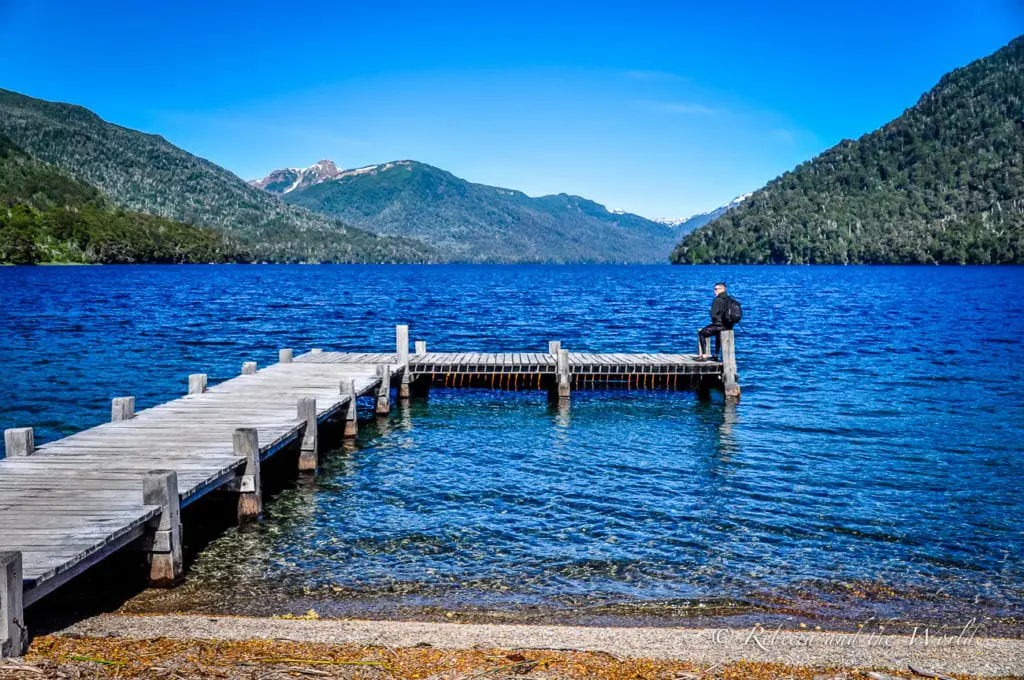
Final thoughts: When is the best time to visit Argentina?
With something to offer every season, when you visit Argentina does depend on your interests and priorities. (And, of course, the best time to travel to Argentina is when you’ve actually got time available for vacation!)
The country is huge and the climate varies from region to region, so factor that in.
If you’ve been wondering when to visit Argentina, I hope this article has helped.
Whichever time of the year you choose, this country will wow you!
Best time to visit Argentina: FAQs
What are the best places to visit in Argentina during the low season?
During the low season, which runs from May to September, there are fewer tourists in Argentina. This is a great time to visit popular destinations like Buenos Aires and Mendoza, as you can enjoy smaller crowds and discounted prices. Explore off-the-beaten-path destinations such as Salta and Jujuy or go whale-watching in Peninsula Valdes.
What’s the average cost of travel in Argentina?
The cost of travel in Argentina varies depending on the season and region you visit – and the economic situation. Generally, the high season (December to February) will be more expensive compared to the low season (May to September). On average, budget travellers can get away with spending around $50-70 USD per day, while mid-range travellers can expect to spend around $100-150 USD or more per day.
Is Argentina safe for tourists?
Argentina is generally a safe country for tourists, but like any other destination, take precautions and be aware of your surroundings. In larger cities like Buenos Aires, pickpocketing and petty theft can be issues, so keep an eye on your belongings and avoid carrying large sums of cash. Overall, as long as you use common sense and take the necessary precautions, you should have a safe and enjoyable experience in Argentina.
Did you find this article helpful? Consider buying me a coffee as a way to say thanks!
When’s your favourite time to visit Argentina?
Related posts
Before you go… you might like these Argentina travel blogs:
- How to plan the perfect trip to Argentina
- Navigating Money in Argentina: A Traveller’s Guide to Money Matters
- Renting a car in Argentina: 17 tips and tricks
- Argentina itinerary ideas: Options for 1-4 weeks
- What to do with 2 weeks in Argentina
- Is Argentina safe to visit for tourists?
ARGENTINA TRIP ESSENTIALS
- Book your flight to Argentina online with Skyscanner. I like how this site allows you to find the cheapest days.
- Find a great hotel in Argentina. Check prices on Booking.com and Expedia online.
- Check out the huge range of day tours throughout Argentina on GetYourGuide or Viator. There’s something for everyone.
- Keep those bottles of wine you’ll be buying safe in these wine bags.
- A copy of the Lonely Planet guide to Argentina will be handy. Also pick up a Spanish language guidebook to help you navigate your visit.
- One thing I always purchase is travel insurance! Travel Insurance Master allows you to compare across multiple policy providers, while SafetyWing is great for long-term travellers and digital nomads.
PIN IT FOR LATER
Save this guide to the best time to visit Argentina to Pinterest for later.
